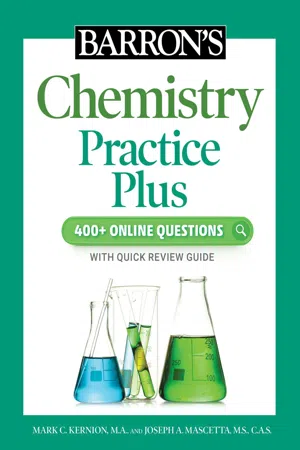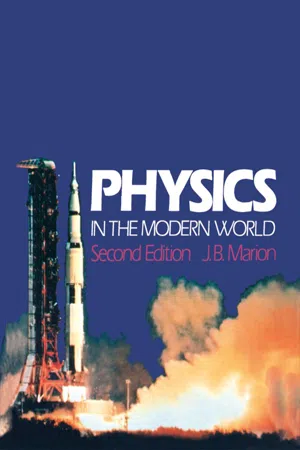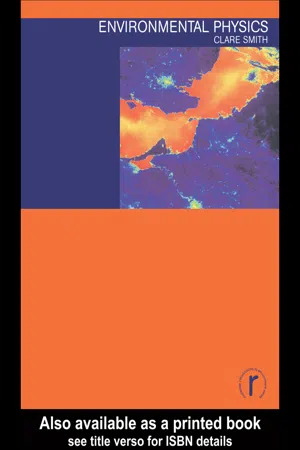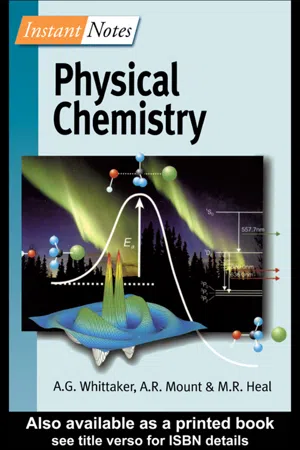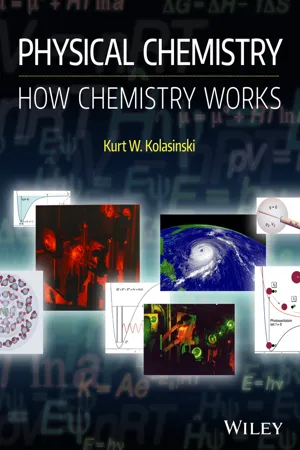Chemistry
Solids Liquids and Gases
Solids, liquids, and gases are the three main states of matter. Solids have a fixed shape and volume, with particles closely packed together. Liquids have a fixed volume but take the shape of their container, with particles that are more spread out than in solids. Gases have neither a fixed shape nor volume, with particles that are widely spaced and move freely.
Written by Perlego with AI-assistance
Related key terms
Related key terms
1 of 4
Related key terms
1 of 3
10 Key excerpts on "Solids Liquids and Gases"
- Mark Kernion, Joseph A. Mascetta(Authors)
- 2022(Publication Date)
- Barrons Educational Services(Publisher)
CHAPTER 7Liquids, Solids, and Phase Changes
Learning Objectives In this chapter, you will learn how to:Describe the states of matter (solids, liquids, and gases).Describe and compare the important properties of solids, liquids, and gases.Describe the various types of phase change.Analyze a phase diagram.Explain the use of liquid water as a common solvent.Solve solubility and concentration problems.Solve colligative property problems in a qualitative manner.Describe the continuum of water mixtures, including solutions, colloids, and suspensions.Liquids and solids are considered condensed phases of matter. By itself, this is a significant differentiation from the phase of matter called a gas. But there are many other important characteristics that distinguish solids and liquids from gases as well as those that distinguish solids from liquids. Macroscopically (i.e., in a form visible to the naked eye), there are several ways to differentiate solids, liquids, and gases. But in order to understand the states of matter well, and in addition how they change from one to another, it is important to be able to envision these phases from a mind’s-eye perspective that takes into account what they are like on an atomic/molecular level.General Characteristics of Solids, Liquids, and Gases
Macroscopically, solids are seen as rigid materials that maintain their shape independent of the container they are in. This rigidity is what differentiates them from liquids and gases, which can both be described as fluid because they can flow and take on the shape of their containers. Although liquids and solids are different with regard to their visible shapes, they are similar with regard to their measurable volumes. Liquids, unlike gases, do not assume the volume of their container. Gases spread out to take up the volume of the container in which they find themselves. Solids act like liquids: their volume is not dependent upon or determined by the container they occupy. Table 7.1- eBook - ePub
- Andrew Rex(Author)
- 2014(Publication Date)
- CRC Press(Publisher)
Chapter 3Solids and Fluids
Life as we know it depends on the diverse properties of matter: solids and fluids. Just think about water in its various forms—liquid, solid (ice), and water vapor in our atmosphere, which eventually returns as rain or snow. And as a whole, the atmosphere contains a mixture of gases in an ideal combination to sustain life. Now think about the house you live in or the building you’re in at this moment. Buildings are intricate mazes full of a variety of solid materials that serve different functions. Solids and fluids also carry waves, especially sound waves, as well as electric current. In this chapter we’ll address some of the vital questions about how the properties of matter affect our lives.What Are the States of Matter?
Common matter is found in three states: solid, liquid, and gas. Technically, the states are the forms that describe the three phases of matter, with each phase describing a range of conditions over which a material’s behavior is uniform. The terms “state” and “phase” are often used interchangeably.A solid has a definite shape that doesn’t change unless extreme forces are applied. In a solid, the attractive forces between neighboring atoms or molecules hold them together to maintain the shape. The atoms are generally packed closely together, where interatomic forces (which are electrical in nature) are strongest. In a liquid, the atoms or molecules are still close enough that attractive forces keep the liquid together as a single substance of approximately constant volume—and hence uniform density. Liquids will flow to conform to the shape of their container. Gases also flow to fill their containers, but in a gas, intermolecular forces are so weak that the molecules are not bound to one another. Because gases have no definite shape or volume, their densities are highly variable based on conditions of pressure and temperature.It’s possible to distinguish between different states for the same solid form. For example, in a crystalline or polycrystalline material, the atoms in a solid form a regular pattern called a crystal lattice. In an amorphous - eBook - ePub
- Jerry Marion(Author)
- 2012(Publication Date)
- Academic Press(Publisher)
10LIQUIDS AND GASES
Publisher Summary
This chapter presents an overview of fluids—substances that do not have rigid structure or form. It explains two different states of matter (1) liquids and (2) gases. The basic physical characteristic that distinguishes solids, liquids, and gases is the way in which the molecules of the materials interact with one another. In solids, the intermolecular forces are strong and the molecules are held tightly together so that, on average, there is little or no relative motion of the molecules. The forces are weaker in liquids, and the molecules readily slip and slide past each other—that is, liquids flow. On the other hand, in gases, the intermolecular forces are quite weak, and the molecules have almost no interaction. Liquids and gases have many similar properties. A pressure applied to any portion of the surface of a confined fluid is transmitted undiminished to all points within the fluid. The chapter explains Archimedes’ principle of buoyancy. It illustrates the energy relationships among the three phases of matter.Thus far, we have been concerned primarily with the behavior of solid objects. We now come to the study of fluids, substances that do not have rigid structure or form. In this category we identify two different states of matter, namely, liquids and gases . The basic physical characteristic that distinguishes solids, liquids, and gases is the way in which the molecules of the materials interact with one another. In solids the intermolecular forces are strong and the molecules are held tightly together so that, on average, there is little or no relative motion of the molecules. The forces are weaker in liquids and the molecules readily slip and slide past each other; that is, liquids flow - eBook - ePub
- Clare Smith(Author)
- 2004(Publication Date)
- Routledge(Publisher)
The differences between these are due to changes in the way the molecules interact, which depends on the balance between each molecule’s thermal energy and the electrical forces between the molecules—that is, a balance between kinetic and potential energy. In a solid, the molecules have relatively little thermal energy and are bound together into a fairly rigid structure by the forces between them. The molecules may vibrate, but not move within the solid. Some solids are plastic, allowing deformation or bending without breaking, while others are rigid and brittle, with a much more fixed structure. As the temperature increases, the molecules vibrate more strongly and start to break free of this structure, forming a liquid which can flow, but which holds itself together and has a surface due to attraction between the molecules. At higher temperatures, this too breaks down to make a gas, and individual molecules can move around freely with little interaction between them. A gas thus has much lower density and no coherence or fixed surface. Liquids and gases are classed together as fluids, which share certain properties such as diffusion and flow. Figure 4.1 (a) Solids, (b) liquids and (c) gases. These are the three states of matter commonly encountered. But if a gas is heated to a temperature of several million degrees, the thermal energy will be sufficient to completely ionise it, that is to free all the electrons from the nucleus. The gas now becomes a plasma, with very different properties, as the nuclei are no longer protected by their electrons and are more likely to collide and take part in nuclear reactions. Plasma exists in particle accelerators used to study elementary physical particles, in the Sun where nuclear reactions take place, and also at much lower densities in the upper atmosphere, where very low pressure gases are ionised by solar radiation - eBook - ePub
200 Science Investigations for Young Students
Practical Activities for Science 5 - 11
- Martin Wenham(Author)
- 2000(Publication Date)
- SAGE Publications Ltd(Publisher)
6States of Matter and Physical Change
6.1: Solids, liquids and gases
Most materials and objects which children encounter in everyday life are fairly obviously in one of three states of matter: solid, liquid or gas. Observing materials to find out how they are classified in this way is an essential preliminary to investigating changes between the three states and ways in which they may be brought about. The three states of matter are sometimes written or spoken about as if there were always sharp distinctions between them; but particularly between the solid and liquid states the distinction is not always clear (Activity 6.2.2 ) and even when it is, it may not appear to be (Activity 6.1.2 ).Activity 6.1.1
Distinguishing solids from liquids
Equipment and materials: A range of (unlabelled) solid objects in a variety of materials, e.g. wood, stone, rubber (elastic bands), paper, modelling clay, plastics, metals. A range of liquids in labelled screw-top jars or bottles with tops sealed on, e.g. water, vegetable oil, thick sugar syrup, PVA glue; disposable cup; dropper; plastic or metal tray.- From all the objects in front of you, pick out the bottles or jars with liquids in them. Put them on one side to look at later.
- Look at the objects which are left. Try to identify the materials of which they are made.
- Try to change the shape of these objects by bending, pulling, squashing and twisting them in your hands. Do not break any of the objects: just find out if you can make them change shape.
- Are these objects solid or liquid? (They are solid.) Are they all solid? (Yes.) Are some more solid than others?
Children may mistakenly answer ‘Yes’ to the last question because they may equate solidity with rigidity or hardness and think that soft, squashy and stretchy materials like modelling clay and elastic bands are less solid than hard materials such as metal or stone.- What properties do all these objects have which makes us call them ‘solid’?
This may need some discussion. The scientific view is that solids maintain their shape without support, although these shapes can be changed by applying forces to them. As children might put it, solids ‘have their own shape’ and ‘stand up on their own’; but there are solid materials which need further investigation to find out how they behave (Activity 6.1.2 - eBook - ePub
- Charles S. Sell(Author)
- 2019(Publication Date)
- Wiley-VCH(Publisher)
their own and will assume the shape of the container in which they are stored. The molecules making up the liquid interact weakly with each other and have no long‐range order, regular structure, or pattern of orientations of molecules. However,short‐range interactions between the molecules of a liquid will hold them together, and so a liquid will, under gravity, settle to the bottom of its container. Since the forces holding the molecules together are relatively weak, it is possible to separate them. A solid object dropped onto the surface of a liquid will penetrate it and fall to the bottom of the liquid, assuming it is denser than the liquid. The weak nature of the intermolecular forces in a liquid will also allow it to flow.Gases
Gases are very mobile and will spread equally throughout the space allowed to them. No interaction occurs between the individual molecules making up a gas.Phase Changes
Substances can be transformed from one state of matter to another. We all know that water is normally a liquid, but in winter or in a freezer, it will become solid and is known as ice. Similarly, when heated on a stove, the water in a pot will form steam, which is a gas, and evaporate. Of course, a gas close to the point of liquefaction is often referred to as avapour. These examples illustrate the effect of temperature on states of matter. The other thing that affects state of matter is pressure. A heavy weight placed on a block of ice will melt it, even if it is as cold as the ice. Water boils at 100 °C at sea level, but on top of a mountain, where the air pressure is lower, it will boil at a lower temperature. The relationships between the solid, liquid, and gas phases of a substance can be presented in what is known as a phase diagram, as shown inFigure4.7.A simple phase diagram.Figure 4.7In Figure4.7, the temperature increases from left to right along the horizontal axis, and the pressure from bottom to top along the vertical axis. The three phases of matter for our test substance are shown in the figure, and the solid lines show the transition from one phase to another. The point P where the three lines meet is called a triple point, because at this point all three phases exist together. Point C is known as the critical point, - eBook - ePub
Chemistry
With Inorganic Qualitative Analysis
- Therald Moeller(Author)
- 2012(Publication Date)
- Academic Press(Publisher)
12 THE LIQUID AND SOLID STATES; CHANGES OF STATE Publisher Summary This chapter presents the inter-relationships among the gaseous, liquid, and solid phases. It discusses some specific properties of liquids and the solid state. It presents the fundamental topic of crystal structure and the internal arrangements of several types of solids. The chapter discuses the importance of defects and explains the occurrence of solid-state reactions. The term “phase” refers to a homogeneous part of a system in contact with but separate from other parts of the system. The chapter presents Kinetic-molecular theory for liquids and solids. It explains the concept of evaporation, vaporization, condensation and vapor pressure. The chapter illustrates the phase diagram for a solid-liquid-gas system. Surface tension is the property of a surface that imparts membrane-like behavior to the surface. The chapter presents X-ray diffraction, interpreted by the Bragg equation. In neutron diffraction, the incident neutron beam is scattered solely by the nuclei, not by the orbital electrons. That makes neutron diffraction useful in two cases where X-ray diffraction will not work: (1) neutron diffraction can locate very light atoms in the presence of heavier ones, and (2) it can distinguish among atoms with similar numbers of electrons, such as those combined in intermetallic compounds. In this chapter we first present the interrelationships among the gaseous, liquid, and solid phases. Gases have already been discussed in detail (Chapter 3). The middle part of this chapter deals with some specific properties of liquids. Finally, we discuss the solid state. The fundamental topic of crystal structure is explored, and the internal arrangements of several types of solids are presented - eBook - ePub
- Allan F.M. Barton(Author)
- 2021(Publication Date)
- CRC Press(Publisher)
CHAPTER 11DISORDERED MATTER
Liquids play an essential role in human activities and in life itself, but the liquid state of matter leads a rather precarious existence. Each covalent compound is stable as a liquid over a relatively narrow range of physical conditions, although metals and salts tend to be liquid over wider ranges.11.1 Condensed States
The quantum model, so successful in describing the structures and properties of atoms and of molecules, also accounts for the existence of condensed materials.The common characteristic of condensed phases is their spacefilling ability. If one calculates the space available for each molecular particle (atom or molecule) as if it were free and gaseous, then the particles would have to be in contact. The most successful models of condensed phases also take into account the sharing of electrons. Electrons that one would otherwise consider to be the ‘outer’ electrons of individual atoms or molecules are not completely localised in this way. Instead, all molecules throughout the material tend to ‘share’ the outer electrons, but to different extents according to the nature of the material.Materials exist in condensed phases as liquids and solids over certain ranges of temperature and pressure because in the appropriate circumstances these states are more stable than the gaseous one. The thermodynamic model provides energetic advantages in having molecular particles arranged in close-packed configurations, either random or ordered. The strong attractive or cohesive interactions existing between the particles cause considerable negative internal energies compared to vapour phase molecular particles. (Vapours have negligible amounts of potential energy of this kind.) The internal energy is negative because one has to supply energy to a condensed system to convert it to a gas or vapour. If the particles are ions, even stronger attractive interactions arise from coulombic electrostatic interactions in materials such as metals, ionic crystals and ionic liquids. - eBook - ePub
- Gavin Whittaker, Andy Mount, Matthew Heal(Authors)
- 2000(Publication Date)
- Taylor & Francis(Publisher)
A1 PERFECT GASESKey Notes
Gases A gas is a fluid which has no intrinsic shape, and which expands indefinitely to fill any container in which it is held. The perfect gas equation The physical properties of a perfect gas are completely described by the amount of substance of which it is comprised, its temperature, its pressure and the volume which it occupies. These four parameters are not independent, and the relations between them are expressed in the gas laws. The three historical gas laws—Boyle’s law, Charles’ law and Avogadro’s principle—are specific cases of the perfect gas equation of state, which is usually quoted in the form pV=nRT , where R is the gas constant. Partial pressure The pressure exerted by each component in a gaseous mixture is known as the partial pressure, and is the pressure which that component would exert were it alone in that volume. For a perfect gas, the partial pressure, p x , for n x moles of each component x is given by p x =n x RT /V . Dalton’s law states that ‘the total pressure exerted by a mixture of ideal gases in a volume is equal to the arithmetic sum of the partial pressures’. The quantity n A /n total is known as the mole fraction of component A, and denoted xA . It directly relates the partial pressure, p A , of a component A, to the total pressure through the expression p A =x A P total . Related topics Molecular behavior in perfect gases (A2 )Non-ideal gases (A3 ) Gases
A gas is a fluid which has no resistance to change of shape, and will expand indefinitely to fill any container in which it is held. The molecules or atoms which make up a gas interact only weakly with one another. They move rapidly, and collide randomly and chaotically with one another. - eBook - ePub
Physical Chemistry
How Chemistry Works
- Kurt W. Kolasinski(Author)
- 2016(Publication Date)
- Wiley(Publisher)
The intermolecular interactions of a liquid are perhaps the most difficult to treat of the three common phases. In a gas, the distance between molecules allows us to ignore interactions in the ideal state and then add interactions as a small perturbation to the ideal model. In the solid state, the perfect order of a crystal introduces symmetry, which greatly simplifies the treatment of interactions. The result of these difficulties is that fundamental theories of the properties of liquids have been the most difficult to advance and lag considerably behind those of the gas and solid phases.Liquid metals and He are exceptional liquids. Helium has two liquid phases, which is also observed for P but still debated for H2 O and S. Helium is, however, the only elemental liquid that cannot be solidified at 1 atm pressure (25 atm are required for solidification), which means it has no liquid/solid phase boundary at atmospheric pressure. Liquid metals are electrically conductive, which indicates that electrons are delocalized because of metallic bonding. Delocalization is a manifestation of the many-body interactions mentioned above. Most molten salts are composed of ions, but there are exceptions such as HgCl2 , which has low electrical conductivity and, thus, must be composed of uncharged species.H2 O is the only naturally occurring inorganic liquid on Earth. It is a truly exceptional liquid. Indeed, if it were not the most important liquid, we might not even study its properties because of the complications of dealing with a heavily hydrogen-bonded liquid with an unusually large relative permittivity that readily autoionizes. However, as it is the most important liquid we will consequently spend considerable effort trying to understand it, and solutions in which it is a solvent.Our first-order model of a liquid begins with assuming that the molecules or atoms which comprise the liquid are nondeformable spheres with a fixed diameter. Their interactions with other molecules are independent of orientation. This is known as a hard-sphere model. A hard-sphere potential gives a good approximation to the thermal conductivity and viscosity of a fluid. This is because these properties are mainly determined by long-range repulsions rather than van der Waals attractions. Condensation of a gas into a liquid requires a potential with an attractive well. A simple and widely used semi-empirical potential is the Lennard–Jones potential (also known as L-J or 6-12 potential). It is defined in terms of the interparticle separation R
Index pages curate the most relevant extracts from our library of academic textbooks. They’ve been created using an in-house natural language model (NLM), each adding context and meaning to key research topics.
Explore more topic indexes
Explore more topic indexes
1 of 6
Explore more topic indexes
1 of 4
